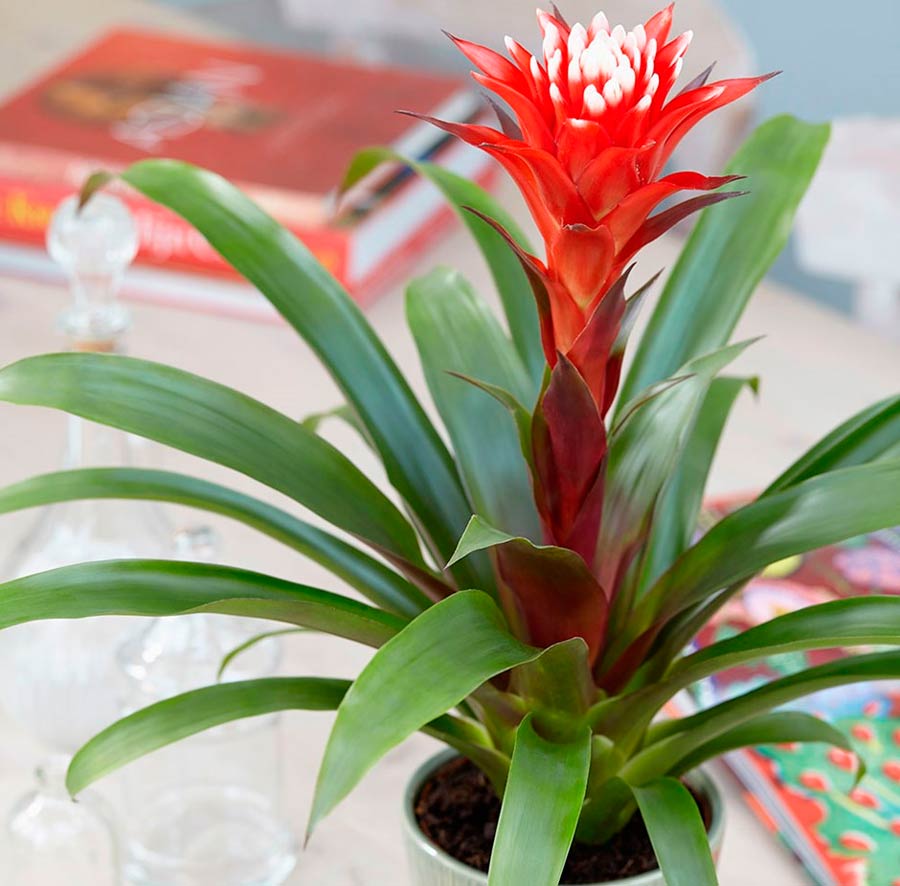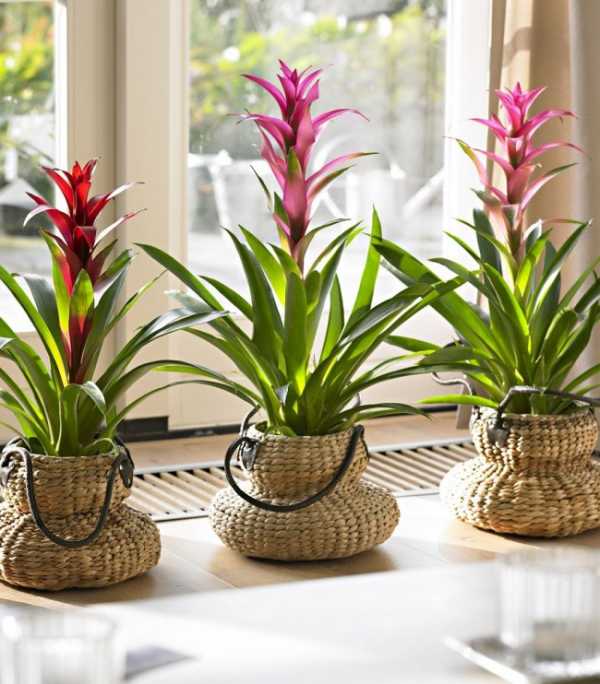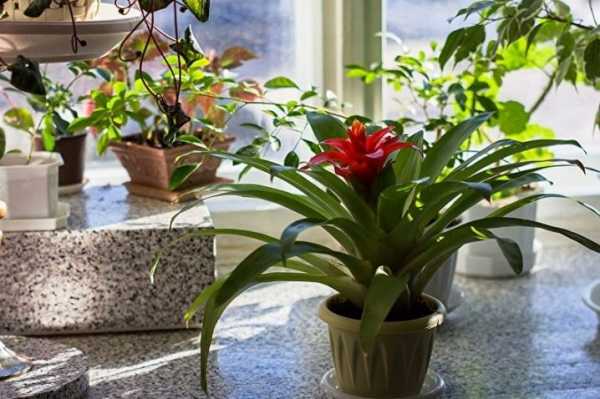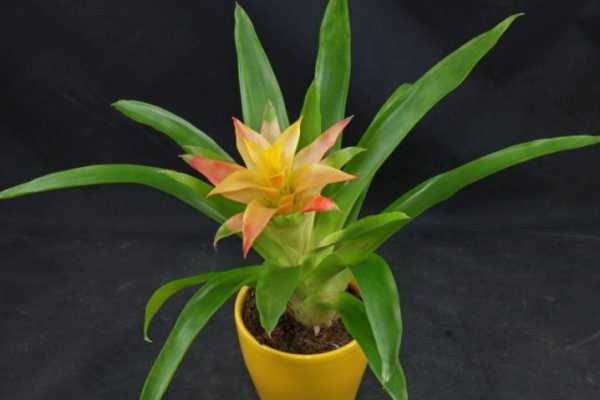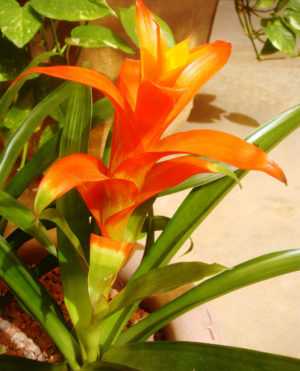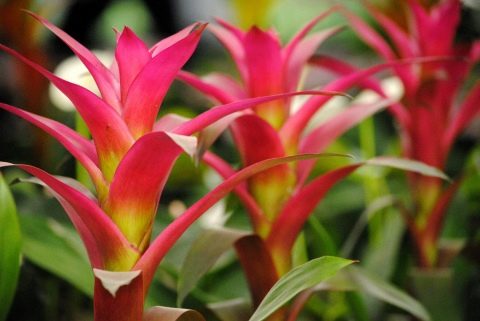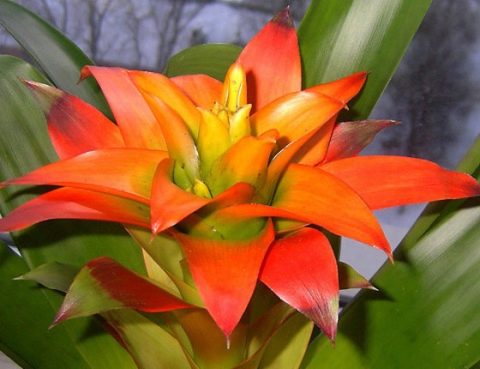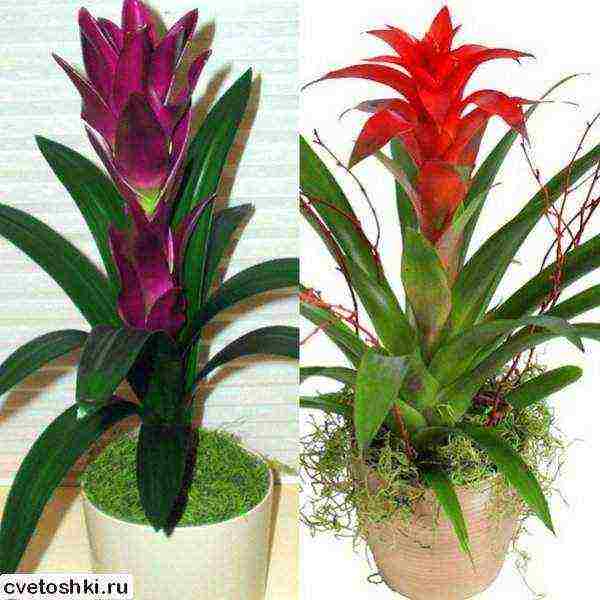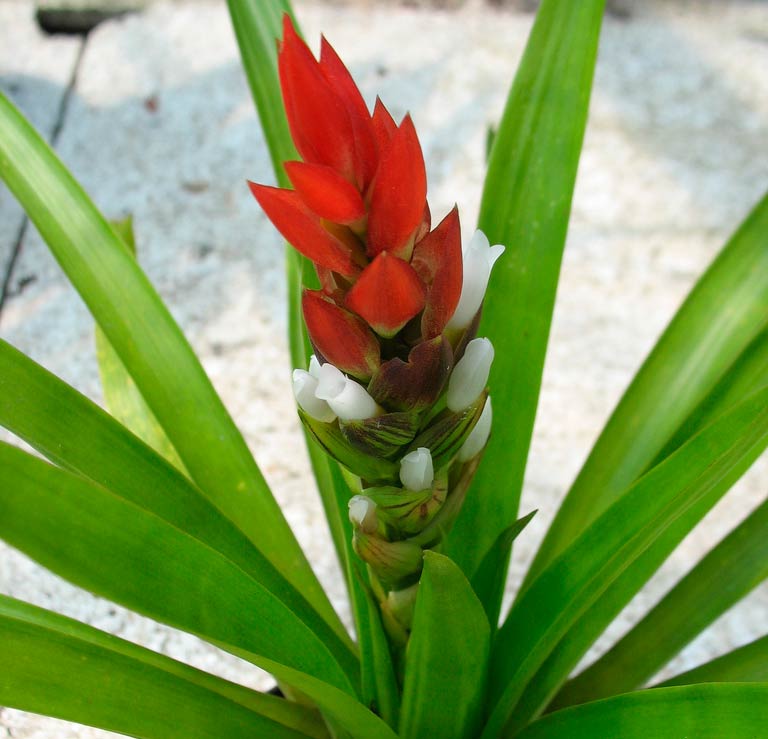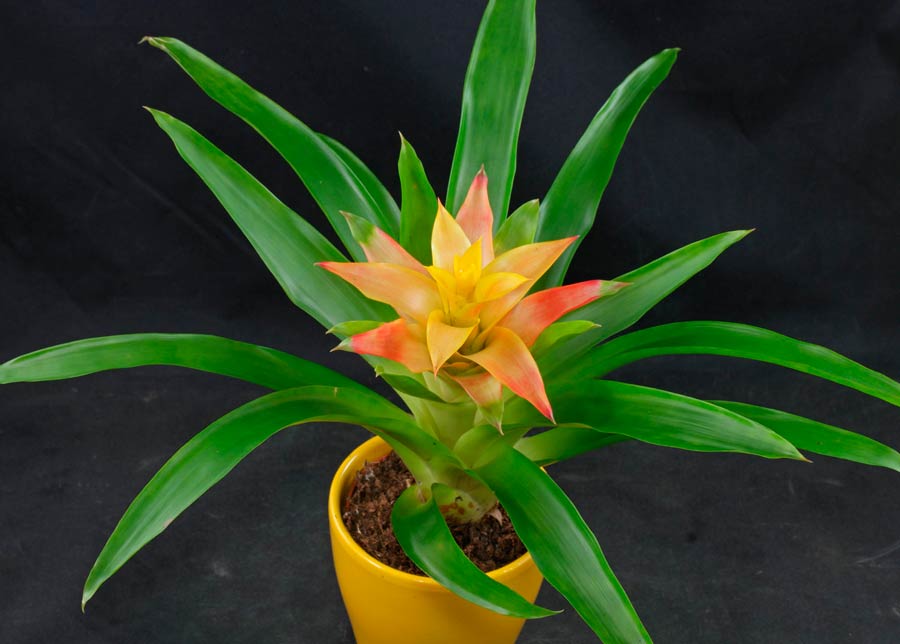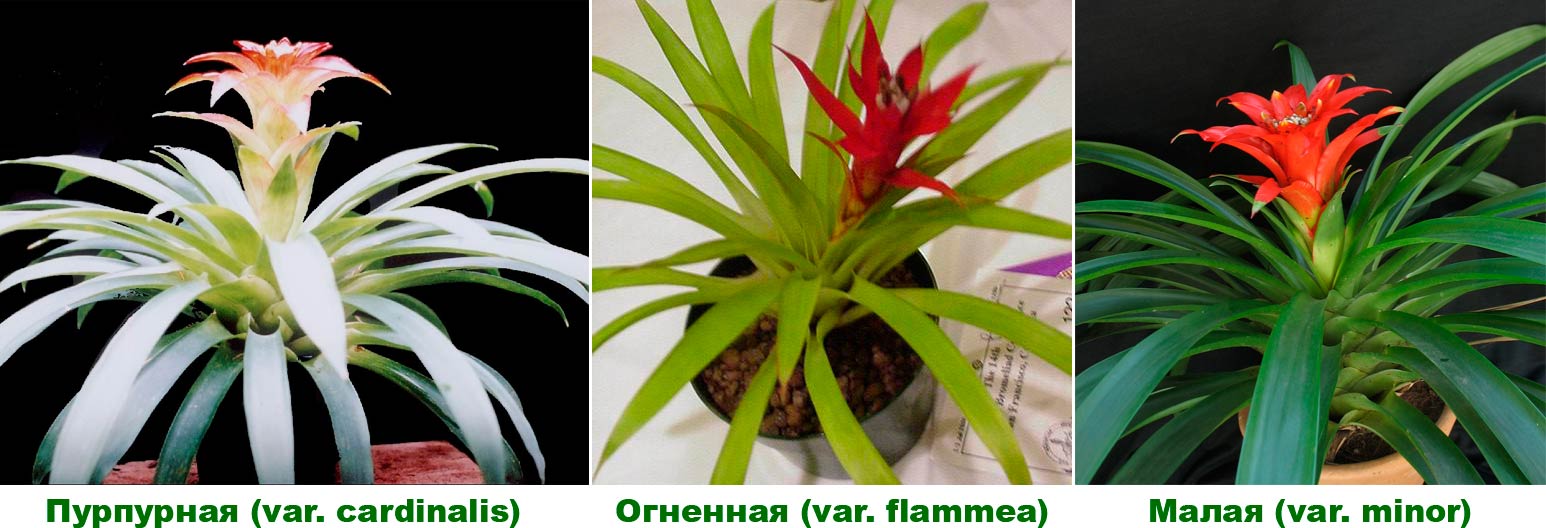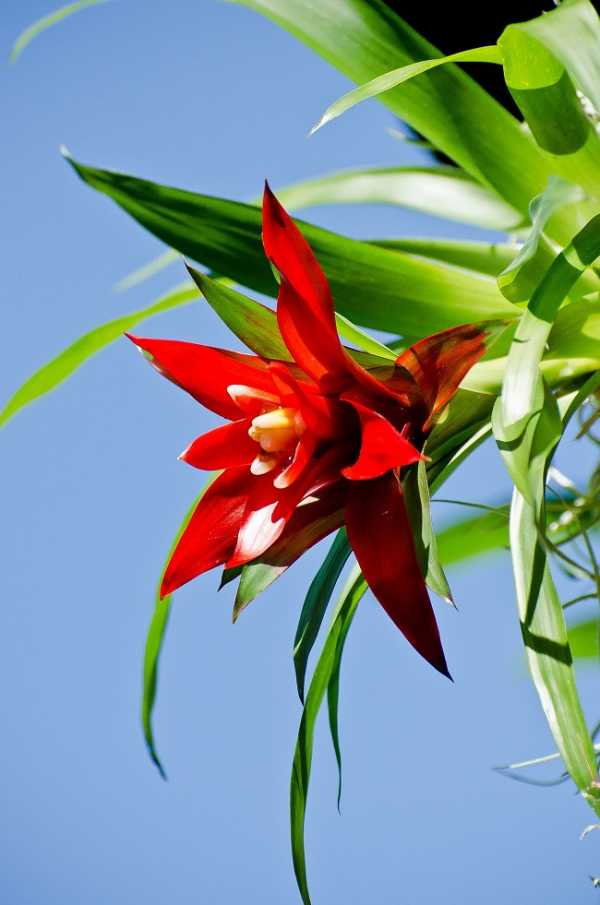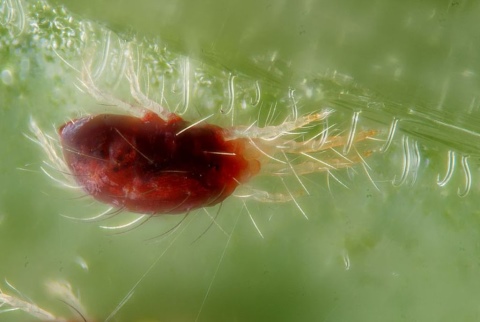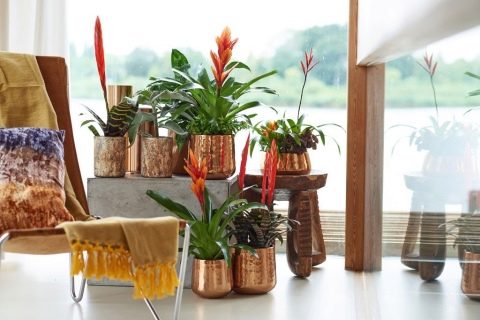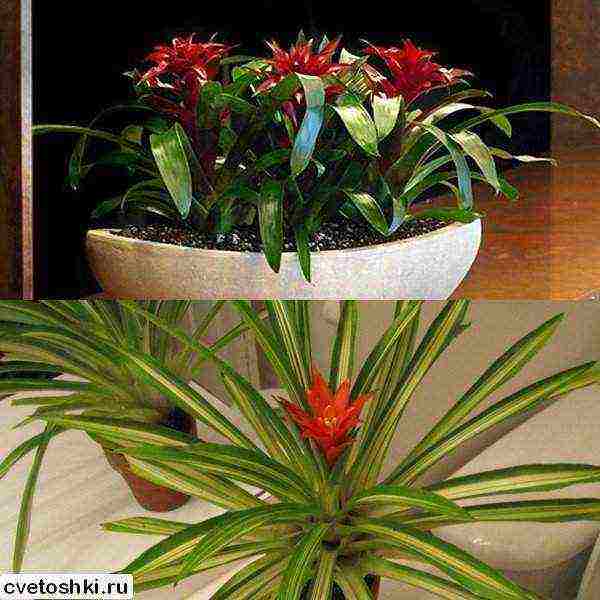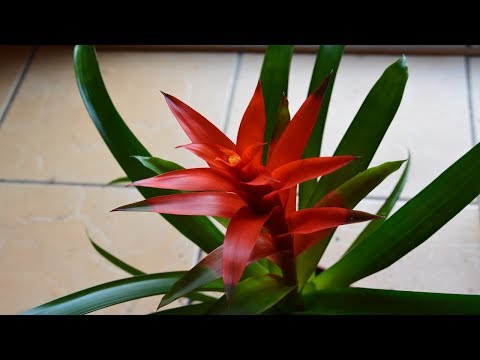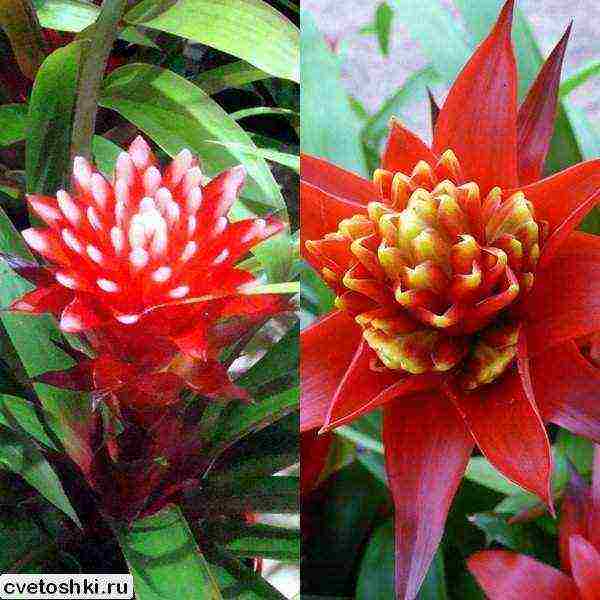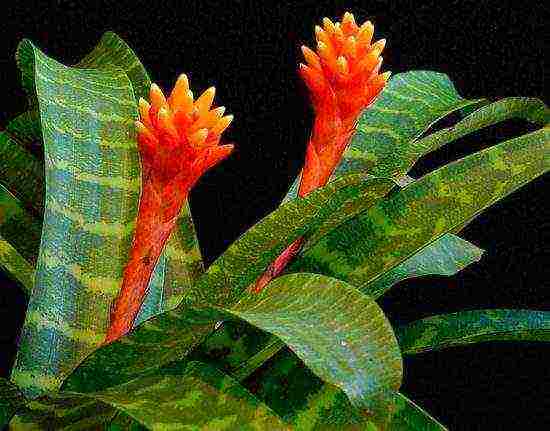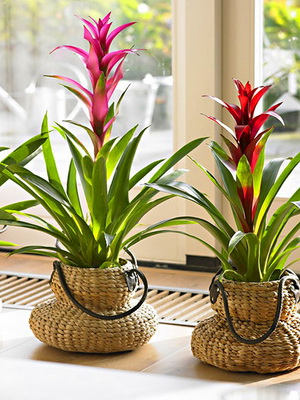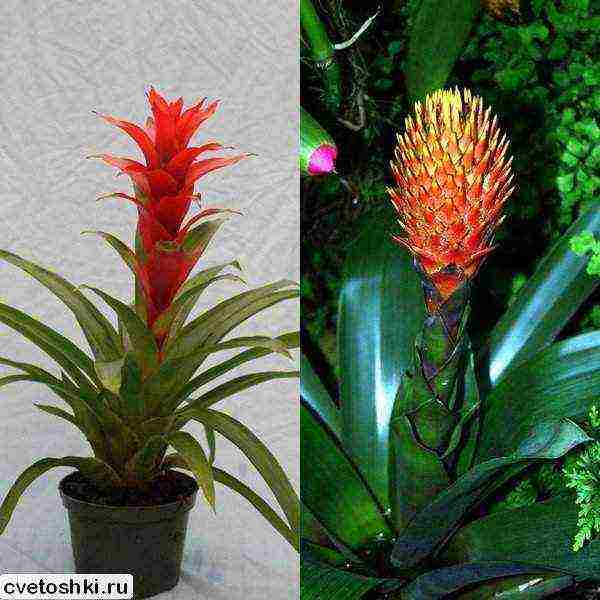Planting methods for guzmania: in pots or on blocks
In indoor culture, guzmania is grown in two main ways - in pots or on blocks. Each of these methods has its own advantages and disadvantages:
| Growing method | Description | Advantages | disadvantages |
| In pots | Plants are planted in a pot filled with loose substrate. | The pot can be placed in any suitable place. It is easy to move it around the apartment. | The moisture content of the substrate is difficult to keep track of and the roots can suffer from rot. |
| On blocks | Plants are grown to blocks of wood and placed on vertical planes. | For the root system, conditions are created that are as close to natural as possible. Plants do not suffer from root rot. | It is more difficult to maintain the necessary air humidity around the plant. Blocks are more difficult to remove and move around the apartment, they need a special place. |
In fact, growing on blocks of guzmania, like any other epiphyte, is the most natural way. However, in an ordinary apartment it is difficult to maintain the high air humidity required by bromeliads. Therefore, most flower growers plant guzmania the old fashioned way - in pots.
If you have several specimens of guzmania at your disposal and there is a desire to plant these plants on blocks, you can create an unusual decor element for your apartment - the so-called "bromeliad tree". It is done as follows:
- prepare a suitable snag - peel off the bark damaged by insects, soak for 2 weeks in clean water, fix on a stand or in a large pot with pebbles;
- remove plants from pots, clean from the substrate;
- wrap the roots in moist Chilean or New Zealand sphagnum moss;
- fix the plants on the driftwood in the right places with a soft wire.
After that, the bromeliad tree is placed in a bright place. With this method of growing guzmans, it is necessary to monitor the moderate moisture content of the moss and often spray the leaves with water.
 In nature, Guzmania inhabit the trunks of old trees. They grow by roots to the tree and do not use any other substrate.
In nature, Guzmania inhabit the trunks of old trees. They grow by roots to the tree and do not use any other substrate.
Pests and diseases
Despite the fact that the plant calmly tolerates very unfavorable conditions, it, like all living things, is susceptible to diseases, damage by many pests. Most often, flower growers are faced with the following problems:
- The scale insect and mite, as well as the mealybug - they affect the greenery of the plant. It is enough to wash the plant with soap suds and rinse the plant with clean water. If this method does not work, you will have to resort to using chemical reagents.
- Stem decay - More often it occurs from an excess of moisture, the root system of the plant rots, therefore it is worthwhile to moderate watering by practicing more spraying.
- Gray rot is a sure sign of a fungal infection of the plant. Therefore, you need to treat it with a fungicide.
- Darkening or lightening of the leaves indicates an overabundance or lack of light.
- The tips of the leaves turn brown - this indicates a lack of moisture or the effect of low temperatures.
Video help for those who are going to transplant guzmania:
Diseases and pests
Guzmania is an unpretentious plant, and yet it happens that it can get sick. This happens when the rules for keeping the flower are violated, improper watering, the use of cold water to feed the root system. To prepare in advance and know about the possible ailments of the plant, you should familiarize yourself with the tips of experienced flower growers.
If gray spots appeared on the spreading and green leaves, then the plant was struck by gray rot. The disease is fungal but treatable. As a treatment, you must use a mixture of fungicide. Processing is done several times.
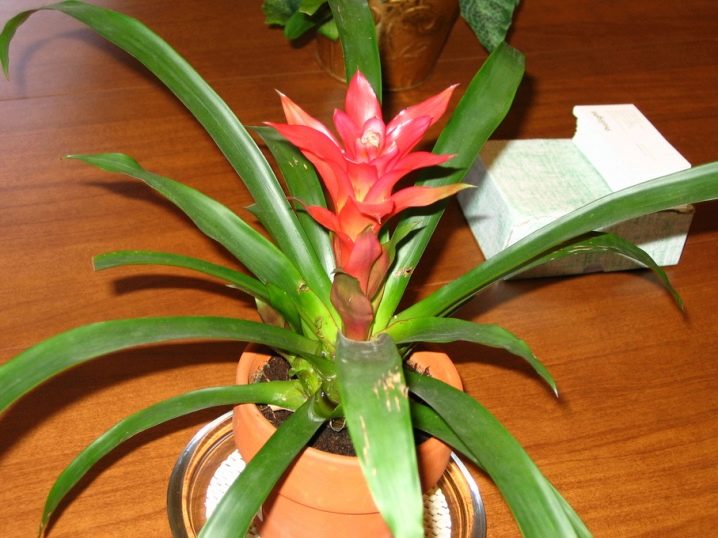







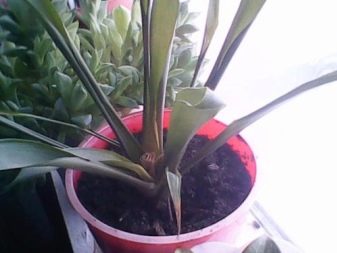

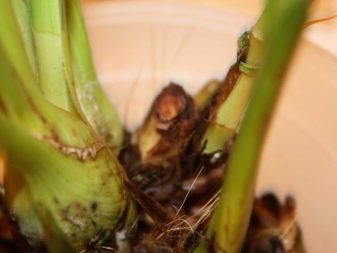



From the presented list of possible diseases, it becomes clear that with timely watering, quality care and decent lighting, the guzmania will not be able to pick up any ailment.
Their appearance is not difficult to determine. The leaves become spoiled, plaque appears on them, a thin cobweb. In cases of the appearance of harmful microorganisms, the leaves must be blotted with a cotton pad previously moistened with a solution of laundry soap. The plant itself will have to be sprayed with an insecticide, for example, "Aktar". "Aktellik" and "Fitoverm" have identical properties with it. You should not come up with ways to dilute drugs on your own. The instructions provided by the manufacturer detail the preparation method for each mixture used.
For the secrets of caring for guzmania, see the video presented.
Diseases of Guzmania
If you follow all the recommendations for caring for guzmania, then it will grow in time, fade and delight with new shoots. But in some cases, the plant begins to wither, for which there are several reasons:
- excessive watering;
- the spread of the fungus;
- sunburn;
- wrong choice of water for irrigation;
- lack of nutrients.
The first is evidenced by the fact that in the center the leaf wrinkles, dark spots appear, water remains in the pan, the substrate is noticeably moist.
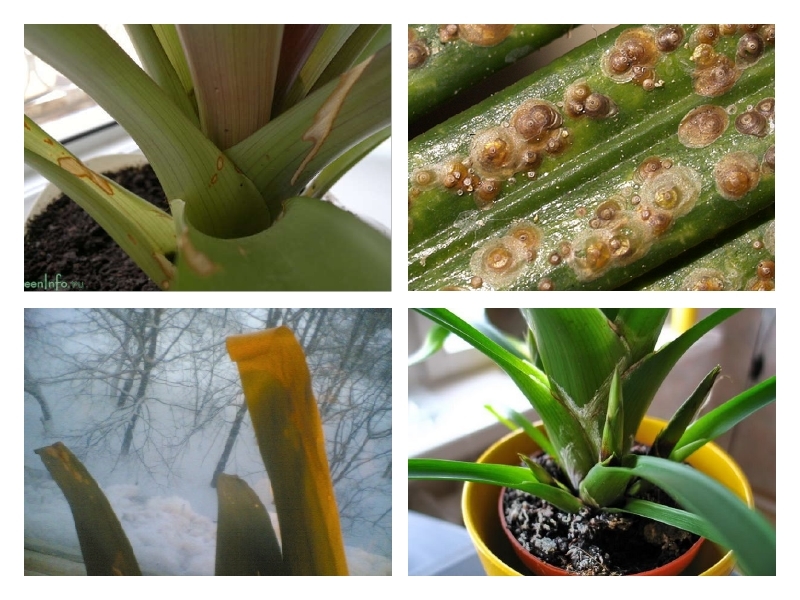
Diseases of guzmania, external manifestations
If a fungus has gone over the plant, then the leaves are covered with a gray bloom. The reasons for the spread of the microorganism are too high temperature and humidity in the room.
If there are brown spots on the surface, this means that the flower is standing in a sunny place and gets burned. The tips of the leaves dry out if the plant is watered with hard or cold water without settling it.
If the guzmania receives less nutrients, then it stops releasing daughter shoots. If the leaves are soft, then it lacks warmth. Some of these problems are eliminated with the use of special medicinal formulations, others as adverse factors are eliminated. Another dilemma that growers face is pests. There are several types of insects that infect epiphytes.
Note! After flowering, the maternal shoot dies. This is a natural process that does not depend on the competence of the care
You can suspect a pest infestation by several signs:
- the leaf becomes covered with yellow spots, and then completely turns yellow and falls off;
- if convex brown plaques appear on the sprout;
- a whitish fluff forms on the surface.
These are the most common traces of plant pests. In the first case, we are talking about a spider mite. You can get rid of it by treating the sprouts with a solution of laundry soap.
The appearance of brown plaques indicates a lesion with a bromelium scale. It is harvested by hand and then treated with a solution of an insecticide suitable for indoor species.
If a white fluff is visible on the surface of the leaf, then these are symptoms of the reproduction of mealybug. Flowers need to be treated with a solution of actara, actellik, bankola.
Placing a guzmania in an apartment and using artificial light
Guzmania, like other bromeliads, are ordinary "tenants" of greenhouses, and professional landscaping decorators often include them in their compositions. But at the amateur level, it is believed that these plants are too troublesome to care for and it is difficult for them to find a good place in an ordinary apartment.
Indeed, the first and one of the main conditions for the successful cultivation of guzmans is bright light, but away from the direct sun. It is impossible to provide this condition in apartments without artificial lighting.Therefore, many flower growers, having bought a blooming guzmania, after a while are faced with the fact that the mother's outlet dies without giving birth to children.
If it is not possible to install additional lighting lamps, you should think about the location of the pot on the windowsill
But at the same time, it is important to take into account the side of the world that the window faces:
| North window | East window | Western window | South window |
| Not suitable for guzmania without artificial lighting. | Poorly suitable for guzmania, because in the summer, in the pre-lunch hours, the plant receives a large amount of direct sun. There is not enough light when using shading blinds. | Poorly suitable for guzmans, if direct sun falls on the plants in the afternoon. When using blinds, the light will not be enough. | Not suitable for guzmans. |
Thus, guzmania can be placed on the east or west window, but only on condition that a tree grows in front of the window, giving a light sparse shadow in summer. From autumn to spring, bromeliads feel good on these windows in sunny weather, but in cloudy weather they will experience a lack of light.
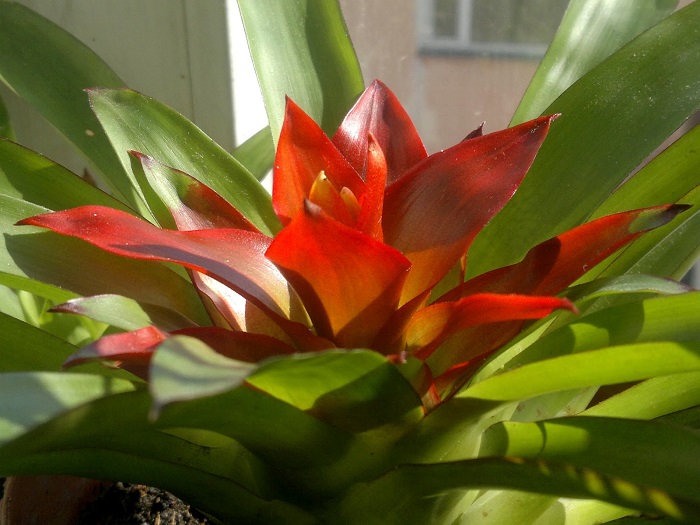 Guzmania comes from equatorial forests. Although they grow under the canopy of tree crowns, the light intensity in this natural zone is much higher than in Russian latitudes. Therefore, guzmania can hardly be called a shade-loving plant.
Guzmania comes from equatorial forests. Although they grow under the canopy of tree crowns, the light intensity in this natural zone is much higher than in Russian latitudes. Therefore, guzmania can hardly be called a shade-loving plant.
Care features
For guzmania to become a favorite, exotic pride and flowering plant, all the necessary conditions for successful growth and development should be provided. It is desirable that they be as close to natural
A place

As with any tropical plant, lighting is extremely important for the development of guzmania. The best location would be the west or east side of the room.
The pot should not be placed on the south side, since direct sunlight, especially in the hot season, is uncomfortable for this plant.
If it is located in the south, then arrange shading for it in the summer.
The north of the room, on the contrary, cannot provide the guzmania with the required amount of light. In this case, the shade of the leaves will be light and faded, and the flowering period can not wait at all.
Try to keep the plant in place with diffused soft lighting. The flower does not tolerate a lack of sun. A distinctive feature of guzmania is the lack of a clear division into periods of dormancy and vegetation. Therefore, the amount of light is approximately the same both in winter and in spring and summer.
Temperature regime
In the summer months, the air temperature should be in the range of +20 - 25 degrees, but in the winter months, when the dormant period of the flower most often begins, the thermometer should be at around +17 - 18 degrees.
Humidity
Maintaining the right level is extremely important for the full development of the plant, since the flower takes moisture not only from the soil through the root system, but also from the air. Overdrying in the room must not be allowed
The optimal level is not less than 70 - 80%.
You can define a flowerpot on the balcony in the summer season or leave it in the kitchen, and in the winter put it in the bathroom, if there is a window there.
Do not leave guzmania near heating devices, where the air is extremely dry. In this case, place an aquarium nearby and place a damp towel on the battery. However, after a while, a damp smell may appear in the room, so ventilate the room more often.
Spraying is required. The procedure must be carried out several times a day. It is advisable that the scorching sun does not fall on the plant after that. Burns may appear on the sheet plates.
You can also pour a small amount of water into the drip tray.
Watering
This flower belongs to bromeliad plants, so the moisturizing scheme is special. Let's see how to properly organize all the processes.

Gently pour a small amount of water into an outlet. Remove the remains after 2 minutes.
Experienced growers advise to leave water in the pan, and moisten the substrate only in small amounts.
Several times every 7 days, in the summer months, when the soil dries well, water
And in the autumn - winter period, you can limit yourself to 1 watering per week.
The condition and quality of the water is important. It is contraindicated to use tap water with a high content of lime and chlorine.
Moisten the plant only with settled, for 48 hours, soft, slightly warm water.
Periodically wipe the sheet plates with a damp cloth to remove dust. You can not fill in guzmania so that moisture stagnates in the roots, and put the plant in a cold and damp place.
Fertilizer
There is no need to come up with complicated feeding schedules, since the flower naturally receives a very small amount of additional nutrients.
During the growing season (from early spring to autumn), in order for the guzmania to actively develop and bloom, apply mineral and organic fertilizers. If the plant is in a healthy state, then it is enough to feed it no more than 2 times every 30 days.
Use a dose amount 4 to 5 times less than indicated in the instructions. Liquid top dressing is poured into the outlet. The excess is removed with a napkin.
Reproduction guzmania
Flowering is the culmination of the life cycle of bromeliads, so with the appearance of a bright flower, you should also think about how to extend the life of the plant. It is possible to save it from inevitable death through reproduction. Florists distinguish two main methods, which we will consider in detail below.
Division of the bush (lateral processes)
At the end of the flowering period, the plant begins to gradually wither, but before the complete withering away, the mother bush manages to release several children, formed in the axils of the lower leaves. For 2–4 months, the shoots are actively growing the root system, and then they can be transplanted into individual pots. Please note that the transplant is carried out only after the young shoots get stronger and acquire strong roots. As soon as the top leaves of the bromeliad begin to dry out, move it to a shaded area and remove the peduncle. Thanks to this, the plant will not waste precious energy on seed formation, which will significantly accelerate the growth of cuttings. During this period, watering should be carried out exclusively at the root in order to avoid rotting of the stem.
The baby, which has reached 10-15 centimeters, must be carefully cut with a knife along with the roots, treated with a garden pitch and placed in a special substrate for bromeliads. To maintain a high humidity, the cutter pot should be covered with a plastic bag.
If you provide a young guzmania with full care, then in 1-2 years it will delight you with colorful flowering.

Most often, the reproduction of guzmania is carried out by the method of separating children (new shoots) from the mother plant.
Seeds
Growing guzmania from seeds is a long and laborious process, so this method is rarely used. So, the soil for bromeliads should consist of crushed peat with the addition of sand. If you are unable to prepare the mixture yourself, the best solution is to buy a substrate made specifically for bromeliads. Before planting, the seeds are washed in a weak solution of potassium permanganate and dried thoroughly. The prepared planting material is sown without embedding it in the ground, since the seeds must be in the light to obtain friendly shoots. The container should be covered with foil or glass to maintain high humidity and placed in a room with an air temperature of 20-25 ºC. Ventilate and moisten the soil as needed. After a few weeks, the first shoots will appear, and after 2-3 months the seedlings can be dived into the ground. After another 4-6 months, young guzmania should be planted in separate flowerpots. With this cultivation, they will bloom only for 3-4 years.

Growth period of seedlings of guzmania from seeds
Guzmania - home care
The plant greatly adores warm and humid air, diffused light without open sunlight. When the guzmania is preparing for flowering, it will need an air temperature of at least 25 ° C, but 20 ° C is already enough for a flowering plant. The lower threshold that a plant can tolerate for a short time is 13 ° C, and, despite the love of warmth, do not keep it for a long time at a temperature of more than 27 ° C, since the guzmania may die. In order to achieve good air humidity at home, sufficient for the plant, you will need to organize daily spraying with purified or at least filtered water for it, moreover, from October to February it is necessary to sprinkle it only in the morning. During spraying, moisture should not get on the bracts, for the reason that this significantly reduces the flowering time.
How to water gusmania
Because the roots of almost all bromeliads are very susceptible to chlorine and lime, they can only be watered and sprinkled with filtered, or even better distilled warm water. The frequency of watering must be such that the base does not dry out: water as soon as symptoms of drying appear on the visible part of the substrate. Water must be poured directly into the leaf outlet. How often you need to water the guzmania directly depends on the conditions that you managed to form it. If the lighting and air temperature are less than recommended, then watering the guzmania will be required less, however, daily sprinkling of the leaves with warm water is mandatory in any case. Mostly guzmania needs moisture in spring and summer, during the period of active growth.
Plant feeding
In the stage of active vegetation - in spring and summer, a beauty from the tropics needs additional feeding. Moreover, in this period, she has the opportunity to please with flowering.
It is desirable to enrich guzmania with a special mineral complex for bromeliads. Or, in an emergency, dissolve a complex (universal) fertilizer for home flowers with water at a concentration 3 times less than indicated on the package. In other words, if 3 caps per 1 liter of water are prescribed on the bottle-bottle, then you need to take 1 cap per 1 liter of water. Feed no more than once every 2 weeks. It is done in a sheet, and not by a root method - that is, the fertilizer diluted in water is poured into an outlet, and not on an earthen lump.
With fertilizers, the secret is moderation.
Flowering period of Guzmania
A predominantly difficult and obligatory aspect in the entire course of home care for guzmania is contained in the flowering period of the plant. It should be noted that the first flowers will begin to appear only after 3-4 years of plant life.
The flowering period lasts several months and at this stage the plant is truly amazing and surprises everyone with its own beauty. But guzmania will bloom only when it grows in conditions suitable for it. During the flowering stage, it is required to take especially good care of creating comfortable conditions, then the guzmania will delight with magnificent flowers for several months.
There is one dexterity, which makes it possible to bring the flowering period closer. On the ground in which the guzmania grows, small apple slices fit near the plant itself, after which they must be covered with a plastic bag. Ethylene, which will be released during the destruction of apples, will fall into the air, which will induce the rapid appearance of flowers in the plant. But you should be incredibly careful in this move, as creating mold on the apples and the bag can infect the plant, and it will not give flowers soon.
Types and varieties
Unfortunately, only some varieties of Guzmania have been adapted to the room environment, but even this small amount can change the general appearance of the mini-garden, complementing it with grace, beauty and spring warmth.
Further, it is proposed to familiarize yourself with those varieties that have managed to take root in a home environment.
"Reed". In terms of its dimensions, the plant is quite large, due to which it is the pride of the collection of any grower. The maximum length of bright green leaves is 50 cm. Their reverse side is decorated with brownish stripes. Despite the slight spreading of the leaves of the flower structure, their dense structure forms a solid rosette at the base of the plant, designed to collect and store liquid. The peduncle is small in size. Its leaves can be red or orange. The flowers in the central part of the peduncle are dwarf in size and yellow-white. The flowering period lasts for three weeks. At this time, the flower takes on a majestic appearance. After the time allotted by nature, the central part of the flower becomes faded and withers, but despite this, the guzmania continues to live, highlighting daughter rosettes.
"Tempo". In terms of its characteristics, the plant is very similar to the "Minor" variety, the only difference is its size. Spreading bright green leaves, due to the dense structure at the base, create a solid rosette. A bright peduncle, often red in color, is complemented by white blotches on the leaves.
"Mix". In flower shops, this type of epiphytes is quite common. The peduncle of a plant can be yellow, pinkish and even burgundy. You just need to make a choice in favor of a particular variation. Guzmania "Mix" was created by breeders by crossing different types of flowers, due to which the plant takes root well at home. By their nature, they are unpretentious, and their appearance makes the mini-kindergarten especially attractive all year round.
"Nicaraguan". Due to its small size, it is ideal for growing in apartments. The dense rosette consists of 16 tongue-shaped sheet plates. The leaves at the base of the flower are wide, tapering to the tip. Their surface is slightly rough to the touch. In appearance, the plant resembles an upright spikelet. In the central part of the peduncle there are small lemon-colored flowers sitting on short petioles. The flowering process of the "Nicaraguan" guzmania mainly occurs in the spring and lasts for several weeks.
Donnell-Smith. The presented variety is predominantly found in tropical areas. Quite often found in the mountains of Costa Rica. But, despite this, she managed to take root in a home environment. Florists are proud of this purchase, since bright bracts and yellow sepals bloom for six months, complementing the mini-garden with special beauty. The rosette of the Donnell-Smith Guzmania is composed of green leaves, the surface of which is covered with scales. The maximum length of the leaf plate is 60 cm, and the width is 3 cm. A distinctive feature of the Donnell-Smith guzmania is the possibility of self-pollination. Its seeds have a small tuft, which helps spread over long distances.
Diseases, pests and methods of dealing with them
A tropical beauty is not only susceptible to pest attacks. It is also at risk of fungus, white limescale and root rot. The most common pests are spider mites, mealybugs, and scale insects.
 Diseases of Guzmania
Diseases of Guzmania
Mealybug is a pest that lives in the root zone and at the base of foliage. By damaging the leaves, the worm causes the appearance of a sooty fungus. As a result of damage, the leaves may turn yellow, there is a lag in growth. To combat it, it is recommended:
- wipe the leaves on both sides with a sponge dipped in a solution of laundry soap,
- water the earth with pest drugs.
The scabbard affects the leaves on both sides. Outwardly, it resembles dark tubercles. Leaves affected by the scabbard turn yellow and die off.For treatment it is necessary:
- remove pests with a sponge dipped in Actellik solution;
- spray the plants with a solution of this drug;
- sprinkle with insecticide solution.
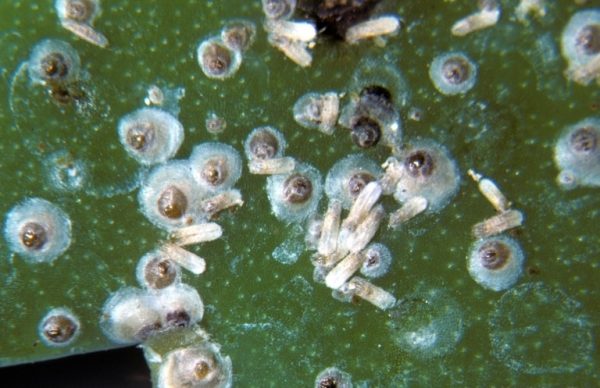 Shield
Shield
Signs of a spider mite are a yellow spot on the leaves. Affected leaves turn yellow and die off. The fight against the parasite includes treating the leaves with soapy water, followed by spraying with an insecticide - Oberon, Sunmight.
Care and reproduction

Observe a certain temperature. Guzmania loves warmth, so in the summer the room should be at least 25 degrees Celsius, and in the winter - 18.
Place the pot with an indoor flower on the west side, as on the south side, direct sunlight will fall on the leaves, and on the north side it is too dark, and the guzmania will not be able to fill the bud.
Stick to the optimum moisture content, which should be at least 80%.
Avoid drafts, otherwise the plant will slow down its growth.
Water once a day during the hot season, and twice a week in the winter. If water remains in the outlet, it must be drained
The water should be defended, and only then carefully watered, directing the stream into the outlet. Guzmania also loves a daily shower.
Spray it every morning, then very soon you will notice how the flower becomes more powerful and more beautiful.
Feed her once a month with a special orchid solution. This can prolong the flowering of indoor guzmania.
Reproduction should be carried out during flowering. When babies form on the flower and reach 12-15 cm, you should carefully disconnect them and transplant them into another indoor pot. After 3 months, the plant will have at least 4 leaves.
Another way of breeding guzmania is growing from seeds. Before this, the prepared seeds are kept in a weak solution of manganese, and then planted in the prepared soil. Then the containers are closed with a bag and placed in a warm room. If everything is done correctly, shoots should appear in 20 days. When the sprouts are slightly elongated, you can transplant them into separate pots, the diameter of which should not exceed 8 cm.
Remember! Guzmania blooms only once. after that she dies for sure. Therefore, try to keep the daughter flowers and propagate them.
It happens that a flower does not bloom for a long time, in this case the process can be accelerated as follows:
- take a whole apple without rot and stains;
- put it in a flower pot and close it tightly with cellophane;
- wait 10 days, while opening the plant and airing daily.
- ethylene released from fruits will serve as additional stimulation for guzmania.
How to care for
Caring for guzmania at home requires a minimum of attention, time and effort. The main thing is to consider several factors that will help prolong the life of your green pet.
Lighting
The plant tolerates partial shade conditions and can grow under artificial light. However, the intense exposure to direct spring-summer sunlight is destructive for him. The best exposure will be in diffused sunlight.
In winter, when there is a lack of lighting, the pot can be placed on the south side. Protect the epiphyte from drafts, which are destructive for it.
Watering guzmania at home
Watering frequency depends on lighting and temperature conditions. In summer and hot weather, the culture needs intensive irrigation. Watering is carried out every 2-3 days, but this regime is observed only at high air temperatures.
In cooler conditions, with a lack of lighting and in winter, watering once a week is sufficient.
The principle is the same as when watering ehmea - water is poured into a leaf outlet so that it slowly penetrates into the soil. Always keep it at the 2.5 cm level.

At elevated temperatures, high humidity is required, which is provided by watering and spraying the foliage 2-3 times a day, and in winter it is enough to spray the foliage once a day.
When watering, try to keep moisture away from the bracts, as this will shorten the life of the inflorescence. The water in the outlet must be changed every 2-3 days to avoid the accumulation of salts and bacteria.
It is best for irrigation with slightly warm rainwater, but if this is not possible, then soft artesian or distilled water will do.
Temperature
The optimum temperature for a flower is 20-25 ̊C in summer and 18 ̊C in winter.
Too low a temperature regime can cause rotting of the base of the plant, a high temperature can lead to the death of the flower.
Top dressing
An exotic beauty does not need constant feeding. Fertilizing flowering crops once a month during watering will extend the life of the peduncle, but the concentration should be reduced by 2 times.
Important!
The composition of the fertilizers that you use should not contain such trace elements as boron and copper, since they are toxic to this epiphyte.
Guzmania transplant
After purchase, the flower does not require transplantation. Like most representatives of the Bromeliad family, indoor guzmania dies six months after the end of flowering.

During this time, a healthy plant produces 2-3 "babies" - lateral processes, which, after the mother's socket dries, can be separated and transplanted into a separate pot.
It is with the help of the children of Guzmania that the culture multiplies.
Reproduction of room guzmania
Lateral processes are separated when their roots reach 1.5 - 2 cm
They are carefully cut with a sharp, sterile knife, and the cut is sprinkled with crushed charcoal. The pot is chosen shallow, since the root system of the plant is superficial
Most species are epiphytes, so the root of the plant acts primarily as an "anchor" rather than a major supplier of water and nutrients.
If you plant them in a mixture that is too dense and wet, then the roots easily rot. The substrate should be very light and loose, breathable and permeable to water.

For planting, use soil for violets or phalaenopsis with the addition of a small amount of leafy soil.
After transplanting, young plants are covered for a while with a plastic bottle and kept warm, creating a humid greenhouse environment. The covers are removed after the children begin to grow.
Diseases and pests of guzmania
Guzmania is a strong plant, it is able to quickly adapt to adverse environmental conditions, but it is often affected by diseases and pests. Fear should be the appearance of a scale insect, a mealybug and a spider mite. They parasitize on succulent foliage, damaging it. Special means or wiping the leaves with a sponge soaked in soapy water will help to get rid of uninvited guests. Insecticide treatment can be carried out from a spray bottle or by adding drugs to water for irrigation... Improper care is often the cause of illness. For example, excessive watering leads to decay of the root system, which entails wilting of the stem and the loss of bracts. If the foliage dries up, the number of watering and spraying should be increased.
With improper care, the guzmania may never bloom.
Why guzmania does not bloom
If an adult plant does not please you with a beautiful inflorescence for a long time, this means that it lacks light, nutrients or moisture. Make adjustments to the guzmania care scheme, and soon it will delight you with bright bracts. Sometimes, due to a lack of fertilizers in the soil or improper maintenance conditions, the plant stops in development, so carefully follow the recommendations of botanists and breeders. Also, growth stops before flowering, since all the forces of bromeliad are spent on the formation of inflorescences.
Why do Guzmania leaves turn yellow
As a rule, the foliage turns yellow due to infection of the guzmania with a scabbard. The insect feeds on the sap of the leaves, so they weaken and die.The affected plant loses its decorative properties, so the parasites should be eliminated as soon as possible. It is not uncommon for foliage to have small, gray, mildew-like spots on the foliage. The reason for their appearance is fungal infections. A fungicide solution prepared according to the instructions will help bring the plant back to life. If you decide to breed guzmania, we recommend keeping several bottles of various drugs at home, which will allow you to quickly solve any problems that arise.
Guzmania is often placed in the bedroom due to its positive effect on male strength.
It is interesting that many interesting facts are associated with guzmania. It is believed that it symbolizes tranquility, harmony, family well-being and brings a stream of positive energy into the house. Rumor has it that the flower is able to activate masculine strength, so it is often placed in bedrooms. Prolonged stay of bromeliads in the house improves the general well-being of residents, cheers up and helps to increase the material well-being of the family. Even if you do not attach importance to such facts and do not believe in omens, the magnificent decorative properties of guzmania will definitely not leave you indifferent. Convince yourself of its beauty and unpretentiousness by looking at pictures, as well as a training video on caring for guzmania.
Join the discussion! We would be interested to know your point of view, leave your opinion


